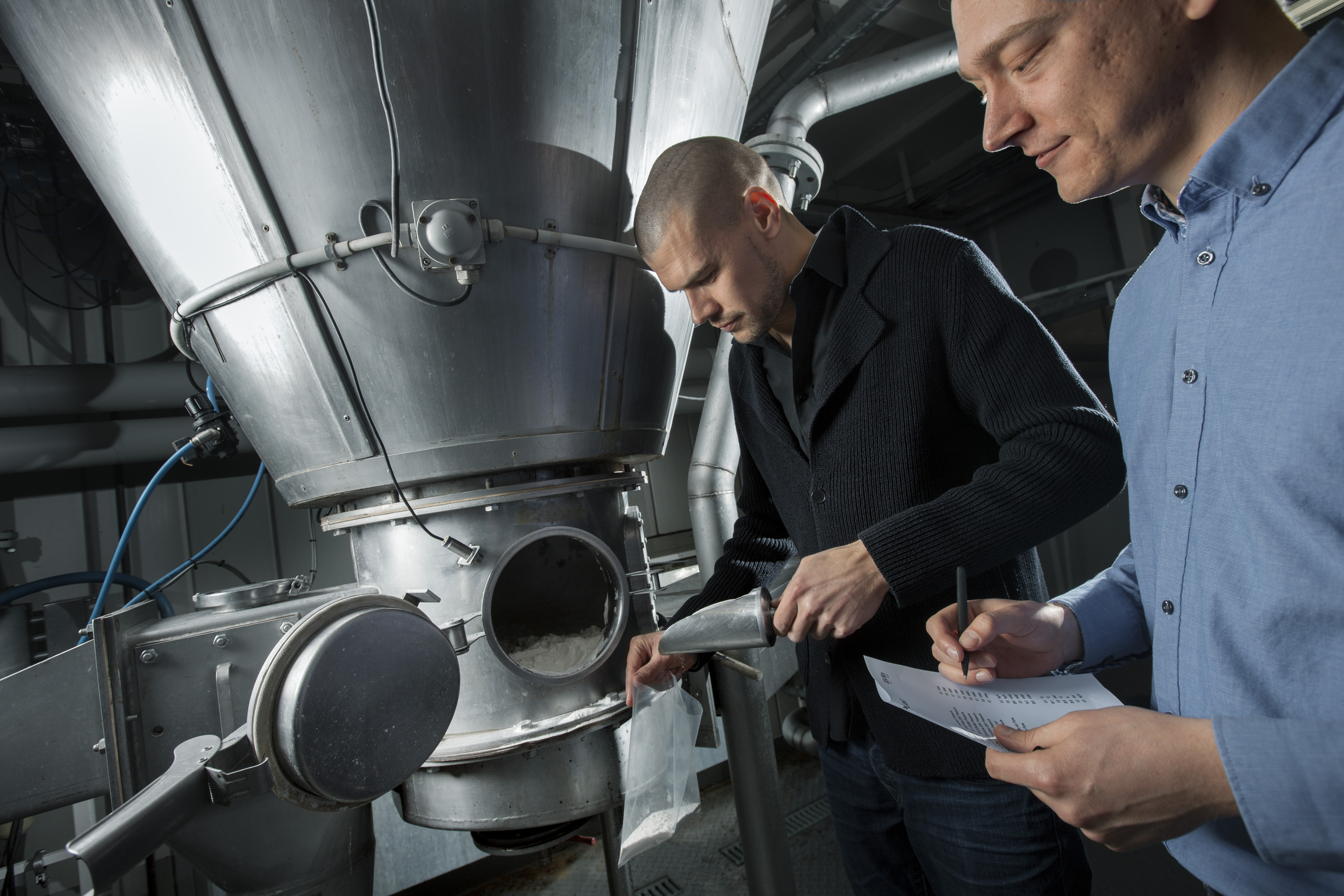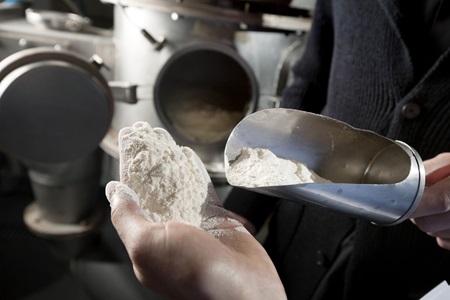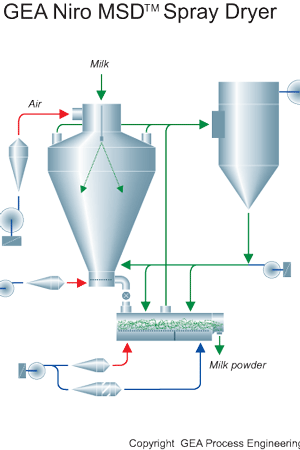Sharp-eyed monitoring software increases powdered milk production by up to five per cent, boosting income and growth for the company GEA Process Engineering, which supplies the units.
Milking machines are pumping away like never before all over Europe. The EU has decreed an end to milk quotas, and production is already far outstripping what consumers can manage to drink.
This has generated a boom in the production of powdered milk. The powder is sold both as formula and as an ingredient for a wide range of foods. So it is with the best possible timing timing that a partnership between the Søborg-based company GEA Process Engineering and DTU has produced monitoring software that significantly boosts powdered milk production.
Two conditions in particular vary in the production of powdered milk: the dry matter content of the milk, and the air humidity level. The dry matter content of the milk depends on precisely how the milk has been processed, and production facilities use large volumes of air to dry the powder. This air is typically drawn from outside, so the humidity of the process air is defined by the season of the year, the location of the plant and the weather conditions on a given day.
Deliberate over-dimensioning of plants
GEA Process Engineering manufactures equipment for purposes including the production of powdered milk, and the company markets its solutions all over the world. When the Søborg-based company delivers an installation, a range of parameters are agreed concerning the quality of the finished product. In the case of powdered milk, water content is always a focus area.
There should ideally be a small amount of water in the finished powdered milk, as this makes it easier to dissolve the powder in water when necessary. However, the risk of bacterial growth increases if the powder is too wet.
The health authorities in the country where the plant is established are responsible for setting the specific requirements on the water content of the powdered milk. The level is typically set at 3–4 per cent water.
Research with commercial value
Lars Norbert Petersen has prepared his industrial PhD project in a partnership between GEA Process Engineering and DTU, and his project has focused specifically on finding a solution for optimal control of the drying process.
"This is a fine example of how a project can combine a very high proportion of research with significant commercial value"
Christer Utzen, project manager at GEA Process Engineering
In his project, Lars Norbert Petersen has developed a modelling tool in the form of a software solution that allows more accurate control of the drying process. This enables the company’s customers to optimise their return by producing powdered milk with precisely the water content desired. The software utilizes the fact that modern sensor technology based on infra-red radiation (IR sensors) can provide accurate, continuous measurements of moisture content while the production process is running.
“The new dimension is that we use Model Predictive Control (MPC), which applies a mathematical model and measurements from the installation to run the plant as close to optimal operation as possible. The mathematical model is used to predict what will happen going forward, allowing the software to adjust the process very quickly,” explains Lars Norbert Petersen.
Even before he has finished writing his PhD thesis, work has already begun on marketing the program under the name of DRYCONTROL™.
“This is a fine example of how a project can combine a very high proportion of research with significant commercial value,” says Christer Utzen from GEA Process Engineering. He is the company supervisor on the PhD project, while Associate Professors Niels Kjølstad Poulsen and John Bagterp Jørgensen—both from DTU Compute—and Hans Henrik Niemann from DTU Electrical Engineering are the DTU supervisors.
 |
|
Project Manager Christer Utzen (left) and PhD student Lars Norbert Petersen check powdered milk produced using GEA’s spray-drying installation.
|
Biggest test facility in the world
Even though DRYCONTROL™ is now ready for sale, development engineers are still required to market the new software and install it in customers’ plants.
According to Christer Utzen, there are great advantages linked to the industrial PhD model: “The partnership ensures we can combine the DTU researchers’ knowledge about the latest theoretical advances in process control with the knowledge about the industrial processes that we possess,” he says.
Lars Norbert Petersen shares this positive view: “GEA has one of the largest powder production test facilities in the world. It is a great privilege to be able to test the solution on such a large scale and under such realistic conditions.”
 |
|
Boom in powdered milk production
The EU Member States currently have to comply with quotas for how much milk they are allowed to produce.
However, the EU has decreed that the quota system will be terminated in 2015. This has meant that European farmers are already investing in boosting production, which far exceeds the demand for drinking milk.
Much of the surplus milk is converted into powdered milk, which is a valuable ingredient in a wide range of foods.
The total production of powdered milk in Europe currently amounts to around 800,000 tonnes per year.
|
Plant supplied by 250,000 cows
The tests under the project were primarily run on a GEA Niro MSD™ test set-up. MSD stands for Multi-Stage Dryer (see fact box). The installation can produce 50–100 kg of powdered milk per hour. By way of comparison, the biggest installation of this type in the world is 200 times the size. That plant, which GEA Process Engineering delivered to a customer in New Zealand, produces 30 tons of powdered milk per hour—the equivalent of needing 250,000 cows to supply the facility.
“Generally speaking, we expect the customer’s investment in DRYCONTROL™ and the necessary sensors to have paid for itself within a year. It goes without saying that if you can boost production at a facility by up to five per cent at such a small extra cost, there are considerable profits to be made—especially for the very large plants,” emphasizes Christer Utzen.
 |
|
How spray drying is used to make powdered milk
Spray drying is the most widespread method for making powdered milk.
The main ingredient is milk, from which much of the water content has previously been removed by standard evaporation.
It is cheaper to evaporate the water than to remove it through spray drying. The milk is typically evaporated down to a dry matter content of around 50%.
The concentrated milk is pumped to the top of the installation, from where it is sprayed down into the main chamber through high-pressure nozzles at the same time as a continuous stream of warm drying air is pumped into the chamber. This removes most of the water content from the drops of milk. As it is impossible to prevent the drying air from capturing a minor part of the dry matter content, this air undergoes a post-treatment procedure. The dry matter collected here is later returned to the process.
Nevertheless, the vast majority of the dry matter content from the milk falls to the bottom of the chamber as powdered milk. The powder is not left lying on the bottom of the chamber, as the bottom is actually what is known as a gill-slit cover. Air is blown across this in such a way that the air and powder mix behaves in the same way as a fluid. This is known as ‘fluidizing’ in the trade. Fluidizing facilitates conveying the powder to one or more drying chambers, where the water content is reduced even further.
|
Based in Søborg, Denmark, the company is a world-leader in drying technology.
GEA Process Engineering supplies equipment and complete production lines based on spray drying, freeze drying, fluid beds and other corresponding techniques. The customer base principally comprises dairies, food companies, breweries and chemical and pharmaceutical enterprises.
GEA Process Engineering is represented in 50 countries, employs around 6,000 people and generates an annual turnover of approx. DKK 13.4 billion. The Group employs roughly 600 people in Denmark, both at the head office in Søborg and at a branch office in Skanderborg.
GEA Process Engineering stems from the company Niro Atomizer, which was founded in 1933. Niro became a part of the German GEA Group in 1993. The Danish company later became the head office for the GEA Group’s process technology activities, and its name was changed to the current version.